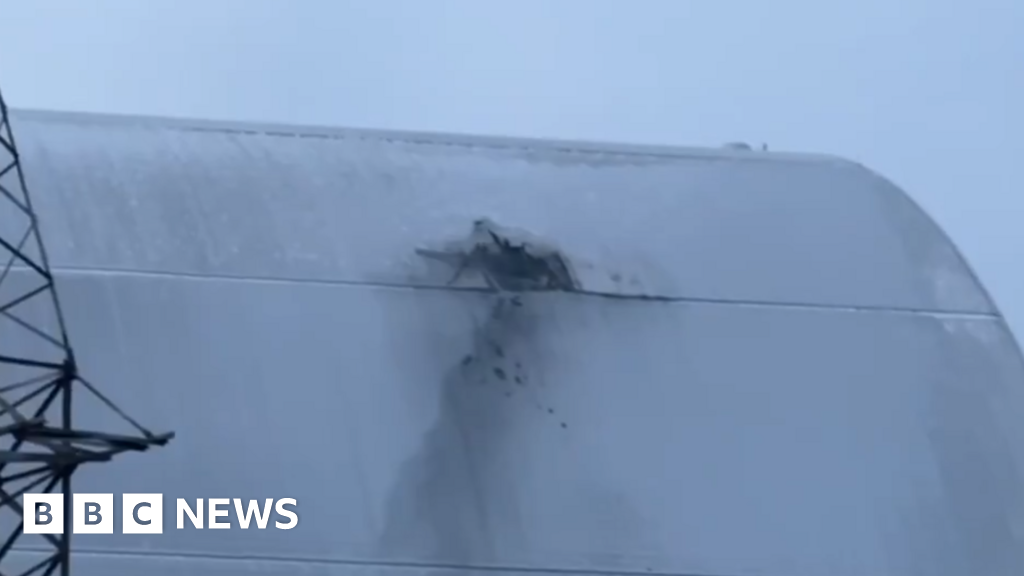Chernobyl radiation shield hit by Russian drone, Ukraine says
- BBC News
A Russian drone attack has hit the radiation shelter protecting Chernobyls damaged nuclear reactor, Ukrainian President Volodymyr Zelensky has said.
The overnight strike at the nuclear plant, which is the site of the worlds worst nuclear accident, caused a fire that has since been extinguished, he added.
As of Friday morning, radiation levels inside and outside Chernobyl remain normal and stable according to the UNs nuclear watchdog (the IAEA).
Russia has denied any claims it attacked Chernobyl, stating its military does not strike Ukrainian nuclear infrastructure and "any claims that this was the case do not correspond to reality".
The International Atomic Energy Agency (IAEA), which monitors nuclear safety around the world, said fire safety personnel and vehicles responded within minutes to an overnight explosion. No casualties were reported, the agency added.
The agency remains on "high alert" after the incident, with its director general Rafael Mariano Grossi saying there is "no room for complacency".
In 1986, a catastrophic explosion at Chernobyl sent a plume of radioactive material into the air, triggering a public health emergency across Europe.
Zelensky posted footage on X appearing to show damage to the giant shield, made of concrete and steel, which covers the remains of the reactor that lost its roof in the explosion.
The shield is designed to prevent further radioactive material leaking out over the next century. It measures 275m (900ft) wide and 108m (354ft) tall and cost $1.6bn (£1.3bn) to construct.
Since 1990, Prof Jim Smith from the UKs University of Portsmouth has studied the aftermath of the Chernobyl nuclear disaster and, while he admits the strike was a "horrendous attack on a very important structure" he is "not concerned" about the radiation risk.
Prof Smith told the BBC a thick concrete "sarcophagus" below the damaged outer shield covers radioactive particles and dust from the explosion.
Simon Evans from the European Bank for Reconstruction and Development (EBRD) was head of the Chernobyl Shelter Fund, which oversaw the construction of the protective dome in the 2010s.
He described the apparent strike as "an incredibly reckless attack on a vulnerable nuclear facility".
The shield "was never built to withstand external drone attack", he told the BBC.
Instead, it is a "complex piece of decommissioning kit" built to contain the radioactive materials inside and to help safely deconstruct the broken reactor.
The strike appeared to hit the maintenance system of a crane designed to remotely take the reactor apart, he said.
There appears to be "pretty serious" damage to the outer and inner cladding, he added. But a fuller assessment of the damage will be needed before the bank can determine its costs.
Mr Evans said the mission to build the shelter was the "worlds largest ever collaboration on nuclear safety", with more than 40 counties coming together to find a long-term solution to deal with the destroyed reactor.
"Ever since the start of the war, its been tragic to see that international co-operation undermined by reckless acts," he added.
Zelensky claimed the attack shows Russian President Vladimir Putin is "definitely not preparing for negotiations", after US President Donald Trump said Putin had agreed to begin talks to end the war in a surprise announcement this week.
The incident at Chernobyl comes after increased military activity around the Zaporizhzhia Nuclear Power Plant in southern Ukraine, the IAEA said.
In December, Ukraine and Russia accused each other of launching a drone attack on a convoy of vehicles transporting IAEA experts heading to the Zaporizhzhia plant, which is Europes largest nuclear station.
IAEA head Rafael Grossi condemned that attack on his staff as "unacceptable", stressing that the agency was "working to prevent a nuclear accident during the military conflict".
The agency last year urged restraint when an attack on Zaporizhzhia raised the risk of a "major nuclear incident". Russia and Ukraine traded blame over the attack in August.
"Im more concerned about Zaporizhzhia than Chernobyl," Prof Smith told the BBC.
"The reactors [at Zaporizhzhia] are currently shut down but there is more live fuel there. Chernobyl is still very radioactive, but its not in a hot state because of its age."
The number of people who died in the Chernobyl disaster remains disputed.
According to the official, internationally recognised death toll, just 31 people died as an immediate result of Chernobyl while the UN estimates that 50 deaths can be directly attributed to the disaster.
In 2005, it predicted a further 4,000 might eventually die as a result of the radiation exposure.